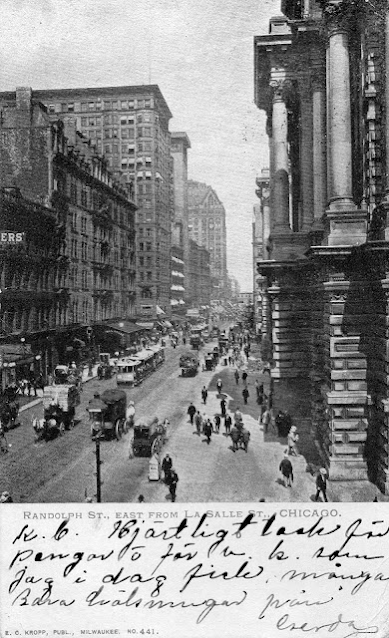 |
Karl XII:s staty. Stockholm. - Förlag Oscar Ellqvist, Nr 9.
(Statue of King Charles XII of Sweden.) |
Tack för kortet! Skrif Snart!
Många Hälsningar från en vän - ALARIK
Thanks for the card! Write soon!
Many Greetings from a friend – ALARIK
8.2.1902
To: Herr Gustaf Ekman, Storegd, Fristad
Some of Gustaf's friends back in the early 1900s seem to have enjoyed sending him anonymous and/or cryptic postcard messages. (I suppose he probably did the same to them.) This postcard from Stockholm is signed using the old runic alphabet:
Runes are very old letters which Germanic people used before they started using Latin letters in the Middle Ages. In its broadest sense, the word runes can mean any cryptic letters, but it usually means the alphabets used by Scandinavian people from about the year 150 AD to the Middle Ages. The oldest of these is called the Elder Fuþark, used from about 150 to 800 AD.
Interest in runes and Old Norse mythology etc had a sort of renaissance here for a while back in the so-called "Romantic Nationalism" of the 19th and early 20th century.
So the name of the friend who sent the card seems to be Alarik. It is an old masculine Germanic name meaning "ruler of all". Whether this was his real name or not, I don't know. But the name Alarik was added to (i.e. given a "name day" in) the Swedish almanac in 1901. (It is still included - 5 August - but I don't think there are a lot of Alariks around in our time. Names do tend to "come and go", though...)
One famous Alarik in history was Alaric I, king of the Visigoths from 395 to 410 - said to be the first Barbarian ruler to invade Italy. He was a professed Christian and was also seen by some Christians as God's wrath upon a still pagan Rome.

The statue on this postcard is of the Swedish king Karl XII (1682-1718), in Swedish history often called the Warrior King. The statue in Stockholm shown on the postcard was made by Johan Peter Molin (1814-73). It's cast in bronze and weighs 2½ tons.
 |
| Modern photo from Wikipedia |

The young women in the foreground on the old postcard are female Salvation Army soldiers, dressed in typical hats, and carrying guitars and and leaflets.
It's one of those street views which may seem ordinary at first glance - just a statue and some random people - but which could just as well be used to convey a hidden message... To me there seems to be a certain irony in the fact that the women soldiers here are turning their back on the old warrior king, and are walking in the opposite direction to where he is pointing!

The Salvation Army, founded 1865 in London, was introduced in Sweden in 1882 by Hanna Ouchterlony. (Wikipedia) She was born in Värnamo, Sweden, in 1838. From 1857 to 1864 she served as housekeeper with relatives in Stockholm; then opened a book shop in Värnamo. In the 1870s, she had a religious crisis, and became active within Christian social work. In 1878, she got acquainted with Bramwell Booth (son of William Booth, the founder of the Salvation Army) who was visiting Värnamo for recreation. She became identified with the values of the Salvation Army, and Booth considered her suitable to introduce the movement to Sweden. Between 1878 and 1881, she took correspondence courses from the Salvation Army; and in 1881, she visited London, staying in the home of Catherine and William Booth. She became an officer of the Salvation Army in London 28 November 1882; and upon her return to Sweden, introduced the movement here.
Hanna served as chief of the Swedish Salvation Army from 1882 until 1892. In 1887–1888, she also founded the Norwegian Salvation Army. She travelled for the Salvation Army in the United States in 1892 and was the territorial leader of the movement between 1894 and 1900. She retired in 1904 and died in Stockholm in 1924.
Linking to Sepia Saturday 691 - On the Street


























